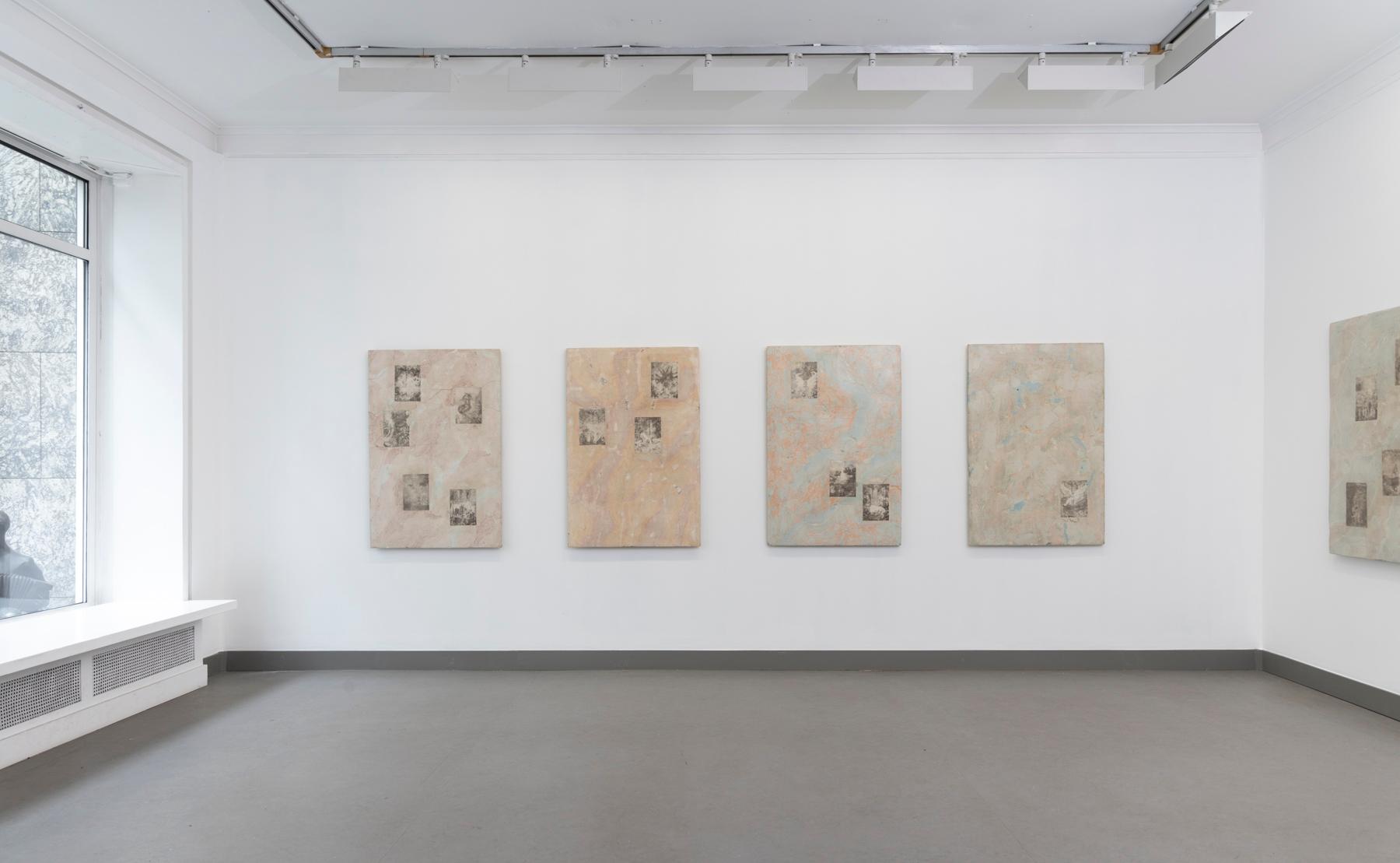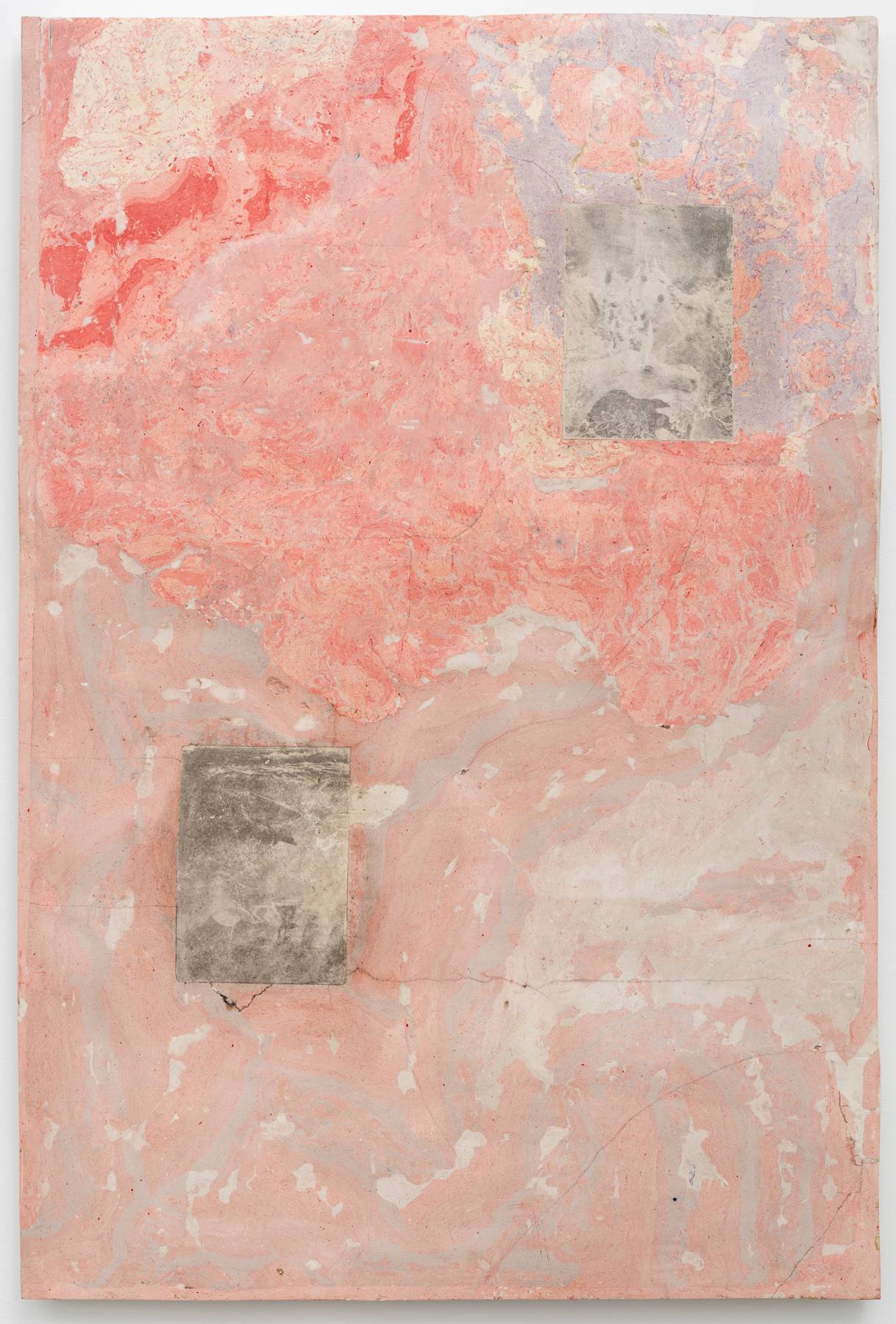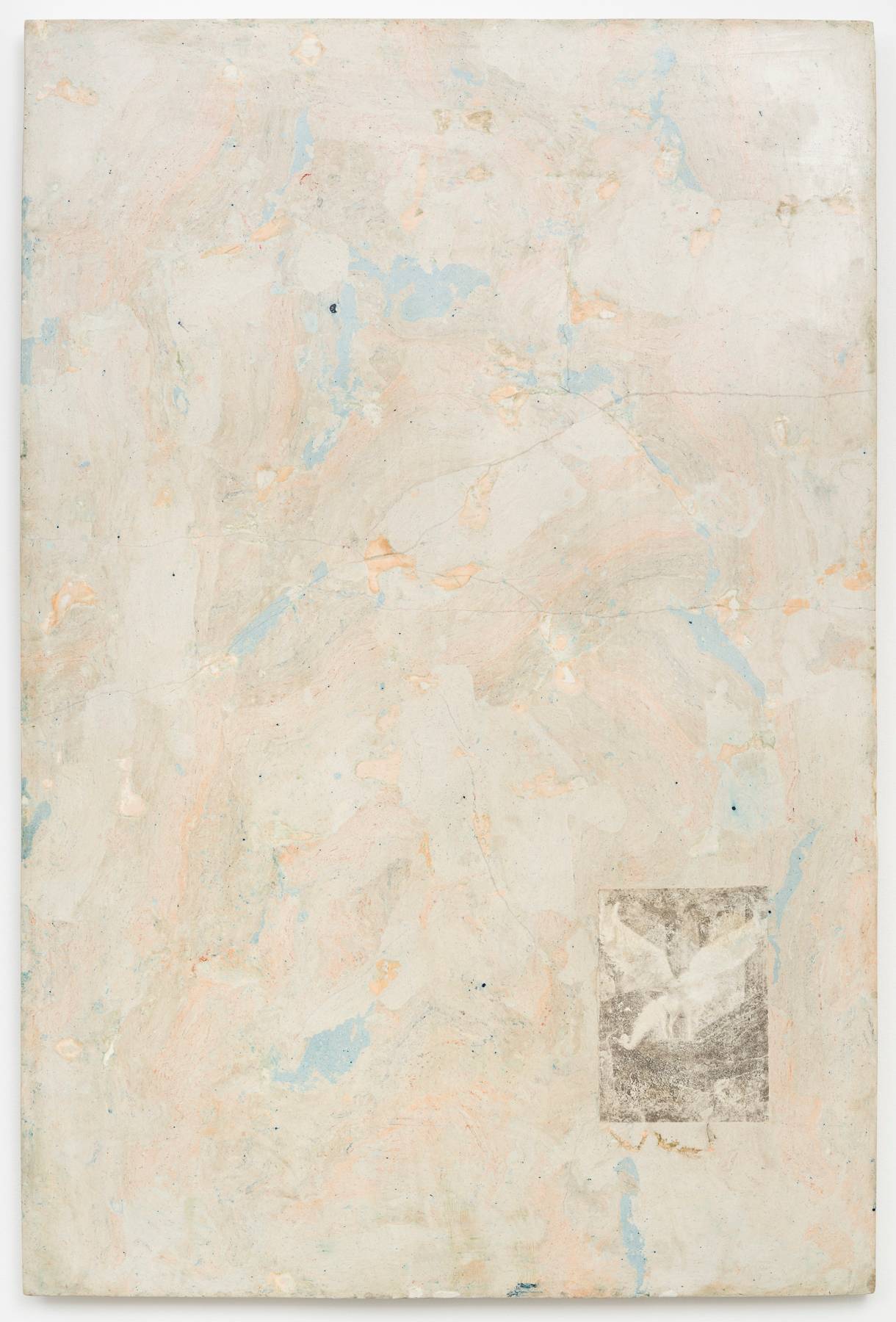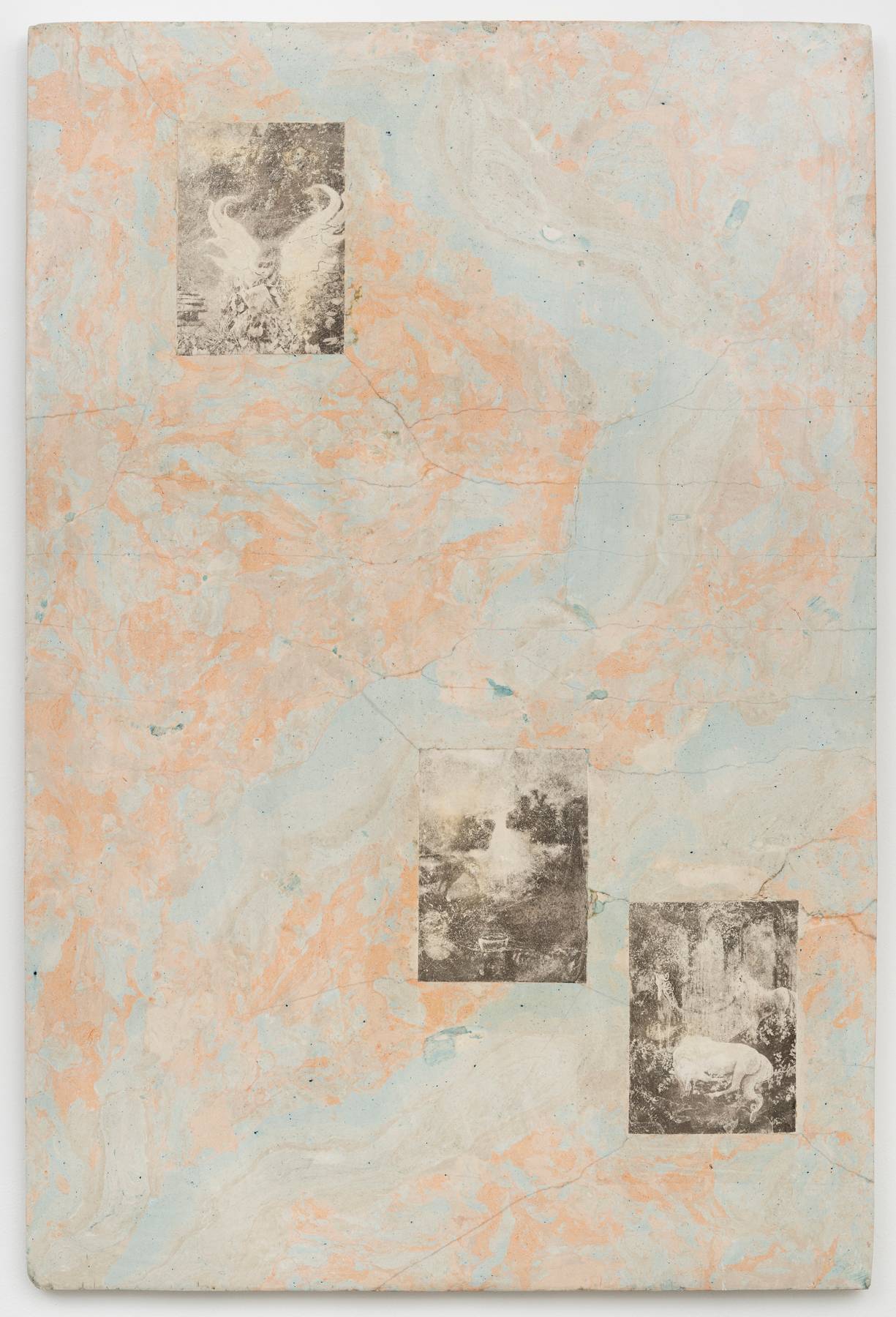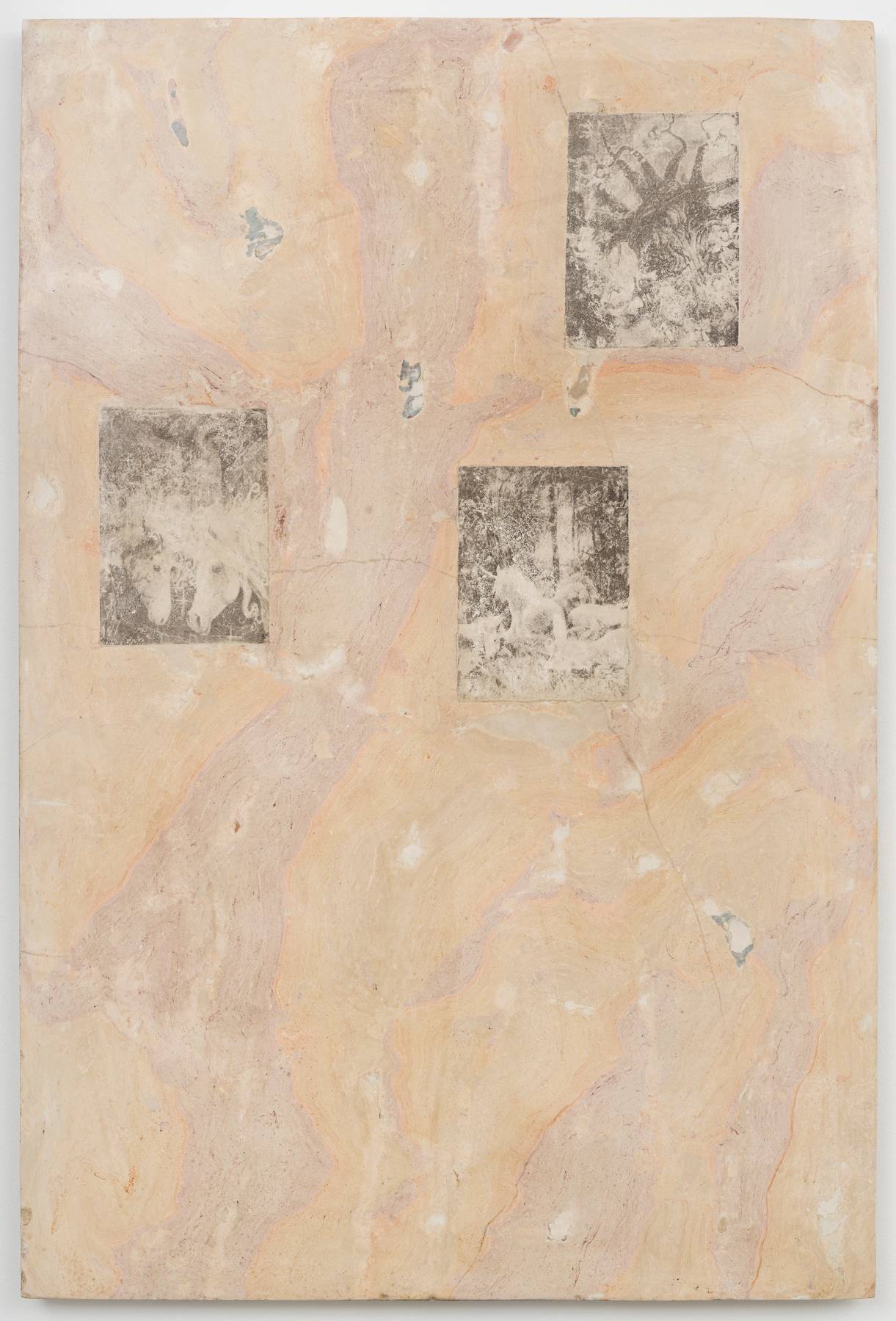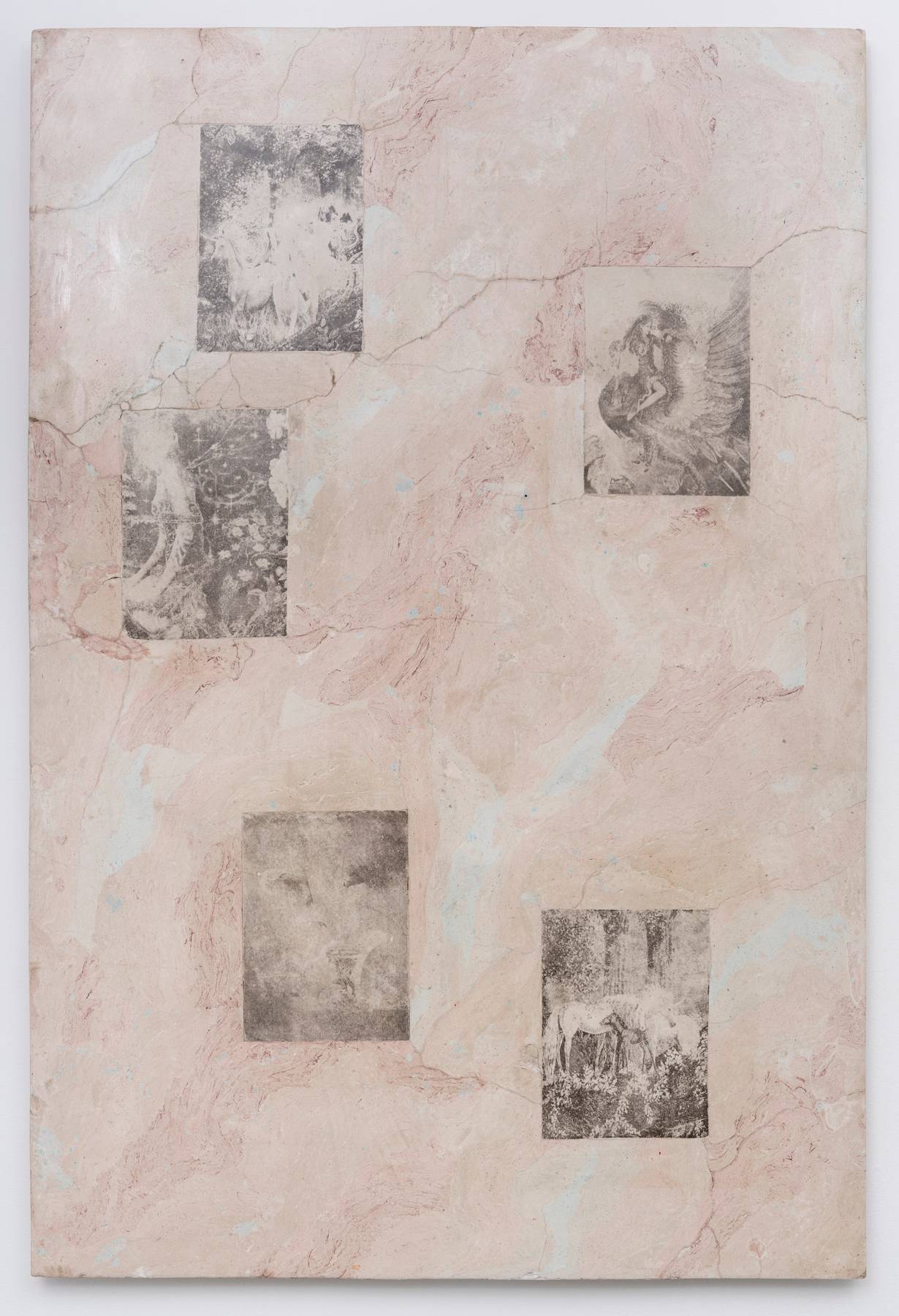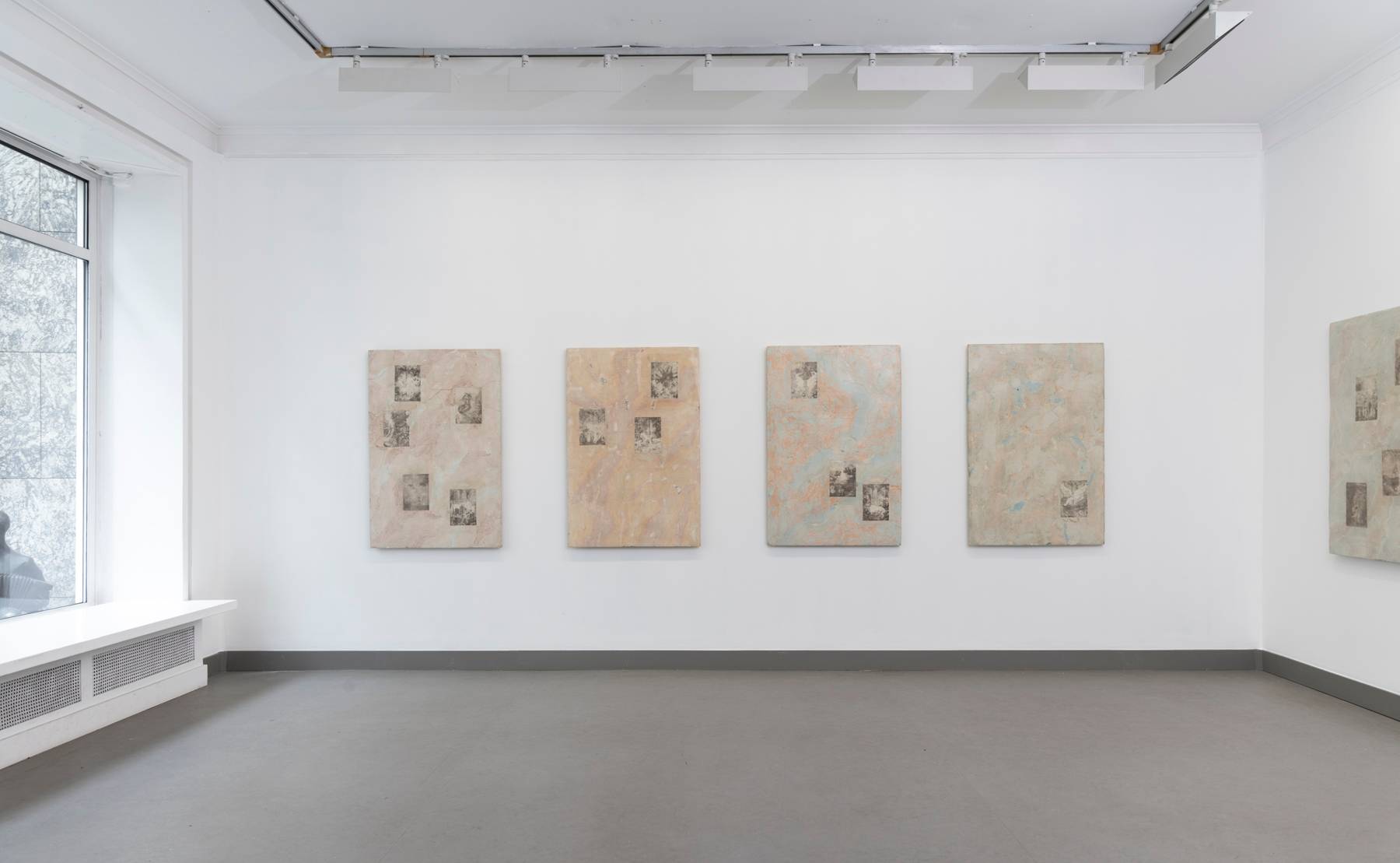Thomas Bremerstent
Tabletops
Vindussalen / The Window Gallery
08.08. – 08.09.2024
Essay written by Eirik Senje
1.
Procedure: The base is made by mixing plaster powder and a solution of hide glue and water. This is done not in a container, but directly on the tabletop, where it is mixed and kneaded, making a dough. Various specks of inorganic matter, colloquially referred to as pigment, are added in, and the dough is folded, mixed, new colour, etc. Then the dough is cut into slices, revealing the strata produced by the mixing and kneading -- it’s almost like a miniature of geology! Each colour delineating its own minute era of that microcosm… The slices are laid out on the table, arranged into a complex in the shape of a rectangle, then melded into each other. When the plaster sets, the glue sets into it, creating a surprisingly tough surface, not at all like plaster. To make it smooth, sanding and polishing follows. A layer of varnish brings out the colour, completing the desired quality.[1]
0.
Proposition:
A: I would tell you what we are doing here, but I can’t. And even if I could… I mean, if I had the power to burst through, all trumpets blazing… a single deafening signal to drown out every other sound and bring us straight to the end… you would want this judgement?
B: I would tell you, but I can’t find my voice. Everything I try to say comes out barely a whisper. It sticks in my throat. It rattles in my throat and whistles across my lips low and mournful, like a final breath. My heart beats sluggishly. I am exhausted. Everything I could mean has been exhausted so soon?
6.
Imaginary scene: The master of the house rubs his neck hesitatingly, still at an impasse. As if on command and without warning, several shafts of light (unleashed no doubt, by the receding of one or several clouds from before the sun) penetrate the chamber from above to play across its walls and interiors. In that same instant, a single short breath enters the master through the nostrils, inflating in a flash his entire posture like a pneumatic tire. Even his eyes appear to widen significantly.
“Seek advice. Challenges ahead” the voices which swirl up there whisper “be a ‘team-player’. Rely on creativity to carry you through” visions all saturated with an unearthly light flicker before his eyes “A leap of faith” sandy beach family holding hands winged man on cliff “follow your dreams” mysterious forest white horse with wings “brilliant new ideas and inspiration. Seeing the truth of a situation. A challenging beginning.” majestic woman with wings “the need for balance and moderation. Cooperation and compromise. Wait for perfect timing. Learn what you can from the situation” beautiful winged man holding golden staff “Look at things from a different perspective. A temporary standstill. It’s important to be yourself.”
A chill runs through him, he turns white as a sheet. Perhaps he is heard to mutter, although more than likely it takes the form of a single thought ringing inside his mind, again and again, like the tolling of a bell, this:
“I can be… not myself?”[2]
2.
Speculation: We introduce elements of chance and lay them on the table, knowing that their being random and nonsensical is of no consequence, precisely because their lack of sense becomes a space for us to project sense into? This card trick, which is not a card trick, works (we think), because we know we can know things without having access to them. We know this, because: when is our knowing ever anything but a response to a query posed to us by the world as we move through it? And so, all we have done here is to intentionally create a point of access… And this as well in response to a query?
4.
Procedure: ‘Angel Tarot’ they call themselves, although they don’t all look like angels, even the ones that do. Who made them? Someone who knows fantasy. Someone who won’t tell you their real name. They find their way into printed matter somehow, and from there, mediated, chances are, by a certain online bookstore, they find their way into a pair of hands somewhere, flying there perhaps on: A wind of yearning? The vague sense of a question somewhere? A gifting? Casual interest? Patterned on previous behaviour? Chance? Later, for reasons beyond even speculation, they leave this pair of hands, and mediated by what appears to be chance, they find their way into the second pair of hands which is rummaging through a place of discarded things, this having presumably caught the attention of something connected to said hands. They are brought home, flipped through, turned over, laid out, drawn at random, studied, pondered upon, mulled over, etc. I don’t know what to make of these, they say (the hands). Let me make something of these, they say (the hands). Later, the cards selected (at random) for transfer will be captured and turned into coded electric signals, before being remanifested as printed matter, black and white rather than the original glaringly saturated and vibrant colours, which is laid upon the appropriate surface, motif down, and sprayed with a particular solvent so that the ink dissolves and can be transferred by drawing a squeegee across the back of the paper.
5.
Imaginary scene: “It is true, I won’t deny it” the artisan is throwing up hands in a pathetic gesture of surrender as he exclaims this “it is not, as such, marble. However, if you will permit it, let me put to you this: the realities of fine stone; heavy; elusive; intractable; were they truly what you had yearned for and pictured in your mind? Was there not perhaps, couched as it were, in such garb as were familiar to you, some deeper and more true desire?”
The master of the house is stroking his chin pensively, eyes cast towards the ceiling, as if expecting that when clarity comes, this will be from whence it descends. The other, sensing opportunity in indecision perhaps, continues emphatically:
“What I offer is far better than mere marble. My marble, which is not marble at all and has no need to be, is indeed that unicorn you once thought you had spotted out of the corner of your eye in a clearing, or perhaps drinking serenely from a crystal-clear lake; it is every marble that marble ever wished it could be and never could be –-- and more! the essential idea of it made manifest, unburdened by trivial fact –-- realer by far, than real… Come now, whatever structures you wish for to adorn the walls of your interiors, you need but say the word, and I shall render them unto you.”
3.
Proposition:
A: You bring me messages again? How delightful! Please leave them on the table and I will look at them in a second.
B: You misunderstand. You yourself are the message, we are in this very instant in the process of coding and transmitting you. Please, hold still a moment.
A: I can’t hear you over all the noise. Will you speak up please? [3]
9.
The following things: Slips of paper, which go into the folders. Then I must give the passkey to the guardian and type in the numbers (after that I will rip the sheet of paper to mark that it no longer holds power over me). Then I must pass through the circles where the dark ones live, that want to trap me in the place where time flows very quick, and all things seem over-ripe with meaning. I must send out messengers in response to those messengers that deserve to be heard, and banish the false messengers that beckon and tempt me with faithless promises. The note with writing telling me I must go and find something must be obeyed. The mug goes back in the kitchen. Where it sat the circle of errant matter summons me to bring a damp cloth. And there’s that collection of words I wanted to look at. Roll of sticky tape, what brings you here? And up and down this ladder I climb, and they all sing to me, and chatter ceaselessly, and swirl like some turbulent sea, and their noise overwhelms m.e… Aand out of this I arise like a signal, bearer of news, sayer of words, I AM THE WORD MADE FLESH etc., and for however long it takes, etc.
8.
Paraphrase: Forgive them, for they know not what they do, and the things they do know not them.
7.
Speculation: We all knew how there may be things dwelling there in the forest, and in the stream, and in the depths of mountains. Things we could not see, but which may be there nonetheless, watching us with keen interest or cold indifference, and according to principles unfamiliar to us or even beyond our reckoning. They would sometimes seem to appear to us as if in a vision not clearly of either mind or eye, beckoning perhaps from a half-glimpsed clearing bathed in sunlight and rife with flowers and wild grass, or breathing threateningly down our neck on a darkened path somewhere, or singing and sparkling to us from a stream coming down a mountainside. Their very elusiveness was what attracted us to them and drove us on, as filled up to the brim with passion, we went chasing after them through our days and nights; and even should one of us meet with untimely demise in the heat of that chase, we never once faltered, for we deemed it worth every peril. And the more they eluded us, the more merrily we chased after them, and the more they got away from us, the more our hearts leapt and sang with joy within our breast, at the miracle that had been granted to us, of these most wondrous things which we could never have.
Endnotes:
1. The referred to technique is called Scagliola, and it functions more or less as I’ve described it. It came to prominence somewhere in the baroque, when it would be used as a form of faux yet highly believable (compared to for instance paint) replacement for marble / fine stone, in pieces of monumental and / or opulent architecture, either or both due to lower cost and weight. It includes many sub-varieties such as inlays, various forms of patterning, stucco etc., and is in general highly plastic compared to working in actual stone, even to the point where the effects which can be achieved in the hands of someone skilled look far more impressive than actual stone, possibly indicating why it seems to be a popular participant in the wild excesses of the rococo period following on the baroque. Thanks to recent developments in search algorithms etc., instruction in this, what would a mere decade or two ago have been a highly obscure knowledge, is now readily available to anyone with access to the internet.
2. The tarot in question (A tarot is essentially a set of cards, like playing cards, which can be used to perform acts of divination, i.e. (more or less), accessing hidden information (how this ‘works’ is the subject of some debate; there are both ‘scientific’ and ‘supernatural’ proposals, and space in between the two, which I won’t get into any further except to say that I find it… interesting, especially in relation to thinking around information and systems), by drawing from the deck at random according to one of many established (or freshly invented) methodologies, and then looking at the picked cards and interpreting their symbols in relation to each other. The agreed upon history seems to be that this concept was developed from actual decks of playing cards somewhere in the 15th century (the application of skill in the interpretation of chance seems to be a common denominator here?)), called ‘Angel Tarot’, seems to be a contemporary reimagining of traditional tarot cards (many varieties of these exist) originally created not very long ago by someone calling themselves ‘Doreen Virtue’ (when I first saw this name, a more than passing resemblance to the name Dion Fortune, self-declared medium and author of books on mysticism who lived about a hundred years ago, immediately stood out to me as conspicuous. Connoisseurs will note, how around that period of early modernity, there was a bit of an esoteric stirring taking place in what we call the western part of the world, and how this seems to be recurring somewhat in our contemporary moment, although obviously according to the ways of that same moment rather than the previously mentioned moment). It uses a hierarchy of angels instead of a traditional tarot symbology, which notably means the more (potentially) notoriously disturbing and contradictory cards from those systems, such as ‘death’, ‘the devil’ etc., have been omitted in preference of a host of helpful angels and arch angels.
The original cards include little blurbs of text (referenced in the referred to paragraph) printed directly on the cards which suggest how to interpret the card. I find their suggestions to be of a highly ideologized character. Also, they remind me of advertisement posters. The inclusion of the blurbs of text directly on the cards per se, seem to preempt the user of the tarot from projecting their own interpretation into the cards, which by my reckoning is itself a highly ideologized move (marketized, consumption oriented, etc.) and would tend to make the whole exercise fairly futile by traditional standards.
In this context, Thomas’ decision to dismember these little blurbs from the cards in his reprinting on the ‘tabletops’ (not to mention how they have been faded and darkened from the eye wateringly vibrant originals, reallowing them some of the shyness mythical creatures crave) seems to me a liberatory act, allowing, so to speak, the unicorns and faeries etc. (which I think could also be cherubim) to roam free and vague again.
3. For more about angels and messages, I can recommend Michel Serres’ ‘Angels: a Modern Myth’, which I did enjoy reading while researching this piece of writing. It’s really quite something. Sadly, it appears to be out of print, but it would hardly be very surprising if someone had made a digital copy of it and made it available for download, or possibly a good library will have it.
Thomas Bremerstent (b. 1992, Denmark) lives and works in Oslo, where he is also educated at the Art Academy in Oslo. He works experimentally with sculptures in different classic and modern materials. He recently completed a residency at the WIELS Contemporary Art Center in Brussels, Belgium. His work has been shown at Trafo Kunsthall in Asker, Vestfold Art Center in Tønsberg, Salgshallen in Oslo, Studio 17 in Stavanger and Galleri Memphis in Oslo. In 2023, he carried out a public arts project for KORO (Public Art Norway).
The exhibition is supported by the Norwegian Visual Artists Fund (BKV) and Arts and Culture Norway.
